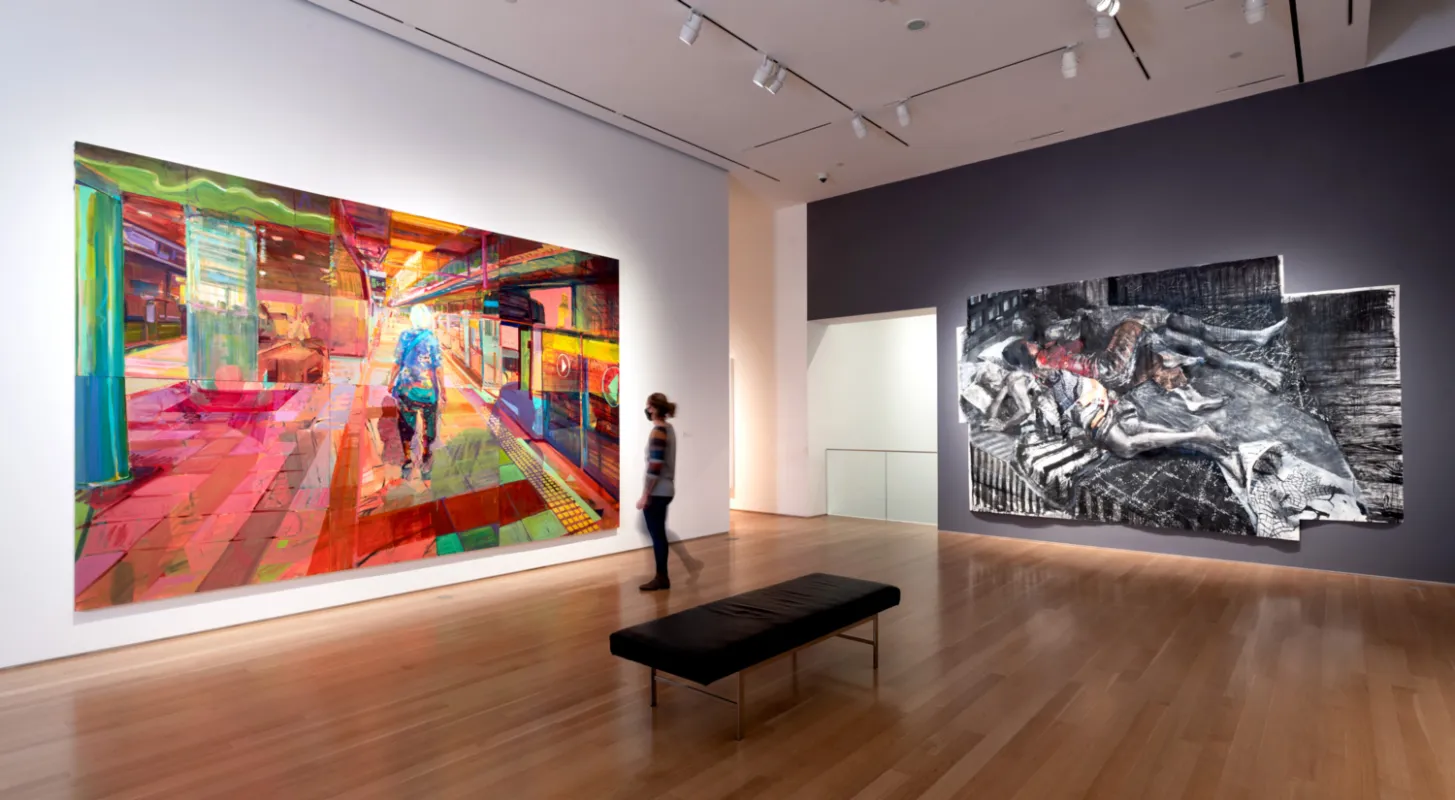Review of Charlotte Street Foundation Fellows Exhibit
Postponed by the Pandemic, the 2020 Charlotte Street Foundation Fellows Exhibit Seduces with Disruption and Delight
After a year deferred, the 2020 Charlotte Street Foundation Fellows finally get their exhibition at the Nerman Museum of Contemporary Art. Recognized for their excellent work and chosen by a panel of local and national curators, the artists receive financial support and exposure through their exhibition.
Cory Imig, Kathy Liao and glyneisha are united by their disruption and reconstruction of physical, emotional and historical space.
Cory Imig’s sculptural works reframe space and renegotiate perception. “Linear Spaces (blue)” comprises two suspended lines of vertical blue ribbons that, curtain-like, create an enveloping wedged space within the museum’s lobby. The work is sexily tactile; the silky ribbons soothe as you run your hand down their strands while entering and exiting the space. While ribbons may connote outdated notions of the feminine, Imig subverts these notions with an artistic practice defined by manipulation of space, time and perception.
Imig’s “Yellow Triangle” and “Saturation” cohabit, charging the space they share as a physical, three-dimensional collage. The yellow carpet wedge runs partially underneath a flat screen whose digital colors shift between green, blue, purple, etc., challenging any idea of color and time itself as fixed.
“Volumetric Form IV” disrupts the lobby architecture, preventing us from interacting with the space in a usual way — floor, ceiling, walls — but rather cuts a kind of metaphysical delineation within that space that charges our bodies with an entirely new experience. Do we walk within the sculpture’s physicality — under it, through it — or do we step carefully around it so as to not disturb its presence? Its sharp edges aggressively cut through space in a counterpoint to the soft effect of “Linear Spaces (blue).”

Kathy Liao
As an artist of Taiwanese heritage, Kathy Liao focuses her work on dislocation of the immigrant family and the rituals in which she and they engage to stay connected. Her highly tactile works in a variety of media employ gesture, collage, paint, drawing and other techniques that create physical and emotional layers. The monumental (11 x 21 feet) and all-encompassing “In Between the Lines” depicts an overwhelming airport interior, with yards and yards of maze-like stanchions that may suggest the bureaucratic and emotional tripwires that immigrants must navigate. A tight (family?) group huddles on the right side of the space, some sleep and some seem to stare into this exhausting space.
Closing the physical and emotional distance from family relies on the mechanisms of modern life. In “liú nián” (translated, fleeting time), a figure stands in a chaotic mass transit space. The pulsating, brilliant colors seem to highlight the figure’s isolation.
Finally, a fracture is potentially healed in “Without,” in which three figures of seemingly different generations lie together in a bed positioned at a raking angle that creates visual and emotional tension. While the work is largely rendered in shades of black and white, a few splashes of red, gold and brown punctuate the dusky space, and the figures’ bare feet lend a tender vulnerability. Is it a dream, or have the figures finally found their solace together?

glyneisha
Subverting the racism and patriarchy of historical museum practice, the green walls of glyneisha’s multimedia and multi-sensory installation “Pack Li.gh.te” begin to redefine the interior museum space, which is punctuated by her traditional framed and collaged works and multimedia installations. “Oral Storytelling Traditions” shows two women on the stoop of a house, engaged within the intimacy of friendship or family. In the graphite works “Fool of Me” and “Measuring the Distance Between Us,” two people uneasily inhabit interior domestic spaces that feel claustrophobic and unhappy, representative of the artist’s breakup memories.
The intent of this newly conceived installation, glyneisha says, is to “honor the Black interior and its relationship to the land as a source of self-actualized healing . . . and examine truths of Black femmedom, personifying in physical form the customs and rituals we use to let go and make space for anew.”
The multimedia “mini (muh nai)” and “aque (uh kweh),” which speak to the artist’s love of Afro Botany — an interdisciplinary practice of traditional African botanies — include shelves of identical glass jars containing spices, dried citrus, family artifacts and other objects, in effect, three-dimensional collages that hold memories and stories, inserting the personal into the public. The entire installation is magnified by a layered audio including work by Erykah Badu, Marvin Gaye, and artist Carrie Mae Weems, whose narratives expand the space.
Like Congresswoman Maxine Waters’ reclaiming her time in her refusal to be talked over, silenced and erased in a congressional hearing, glyneisha, through her autobiographical work, reclaims and redresses the fragmentation of her past and of a culture ruptured by systemic racism and dislocation.
We are all travelers in these shifting spaces of building and of dismantling, and of memory and experience.
“Charlotte Street Foundation Fellows · 2020” continues at the Nerman Museum of Contemporary Art at Johnson County Community College, 12345 College Blvd., Overland Park, through April 24. Hours are 10 a.m. to 5 p.m. Tuesday, Friday and Saturday, 10 a.m. to 8 p.m. Wednesday and Thursday, and noon to 5 p.m. Sunday. For more information, 913.469.3000 or www.nermanmuseum.org.
All photos by E.G. Schempf


